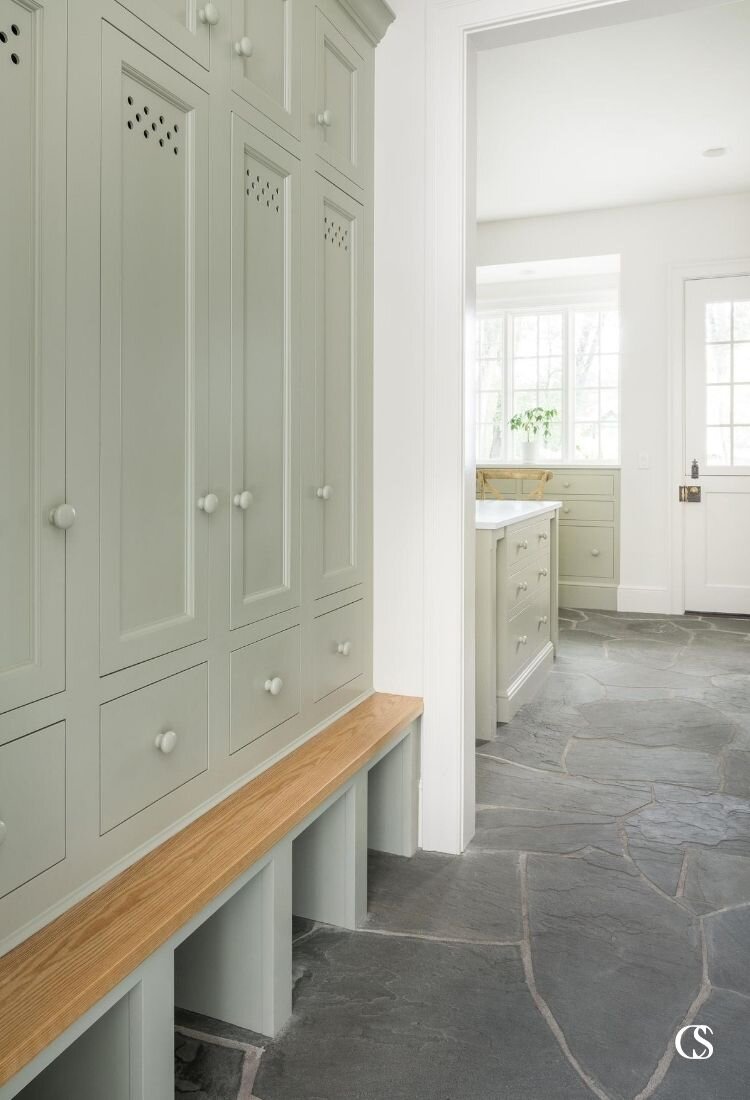Mudrooms are becoming increasingly popular in American home design and we’re swooning over the gorgeous pictures popping up in our various feeds. But what IS a mudroom and why is it important for your home? Read on to find out the what, why, and our favorite hows for making the most of your mudroom space, storage, and decor.
What Are Mudrooms?
A mudroom is a place to kick shoes off and store shoes, hang coats, hats, and bags, place baby seats and briefcases, store sports gear, and organize mail, packages, and more. It is a dedicated space in your home that ensures the rest of your home can stay neat and tidy.
Why Is It Called Mudroom?
A mudroom is the perfect place to kick shoes off, hang coats and hats, store sports gear and bags, place baby seats and briefcases, and organize mail, packages, and more. It is a dedicated space in your home that ensures the rest of your home can stay neat and tidy.
But the best mudrooms are more than just a utilitarian storage closet. While they’re perfect for housing equipment you don’t want to be left out in the weather or vulnerable to thievery (think umbrellas, skis, snow boots, and even bikes), it’s also an important organizational mecca for the household where one can always find their coat, shoes, or backpacks. Plenty of our favorite mudroom ideas and designs include locker-style cabinetry for ultimate organization and separation of personal items, so that the room remains neat and tidy even as it serves as a sort of catchall for the home.
If you’re planning on adding a mudroom to your home, it’s important to consider size, layout, storage options, and location.
PROJECT DETAILS
Cabinet Paint: Chantilly Lace (OC-65) by Benjamin Moore
Floors: Marble
Designer: Christopher Scott Cabinetry & Design
Hardware: Pewter
Where Is The Mudroom Located?
A mudroom is typically and strategically located between the garage and main living space, or any high traffic outer door and the living space—though not usually the front door as that normally leads to the more formal entryway of the house. Off the kitchen is another common mudroom location. The key for an ideal mudroom locale is that it’s off the beaten path for visitors, but right where the high traffic for family members is.
That said, don’t make the mistake of thinking that a mudroom has to be tucked away and totally off-limits, like an eyesore you never want the outside world to see. The right mudroom design will mean that you may not only enjoy spending time there, but that you’ll appreciate showing it off to guests, too.
But what if you don’t have the space built into your home for a ready-made mudroom area? Don’t worry—with a little creativity and the right designer, you can make several other areas of the home double as a fun and functional mudroom. The laundry room, a utility room, extra garage space, and even a walled-in porch can serve perfectly as your new mudroom space.
Is There A Difference Between Mudroom Vs Entryway?
Entryways are considered a more formal introduction to your home. They’re intended to stay cleaner, store less, and are less focused on durability in their design since an entryway’s purpose might be looks and impression as opposed to function. An entryway is typically located at the front of a house, while a mudroom is on the side or back of a house, depending on the floor plan.
A mudroom is all about storage and functionality, rather than being the first thing people see when they walk in your home. While they can still be stylish and beautiful, mudroom storage benches and cabinets are there for practical organization and utility.
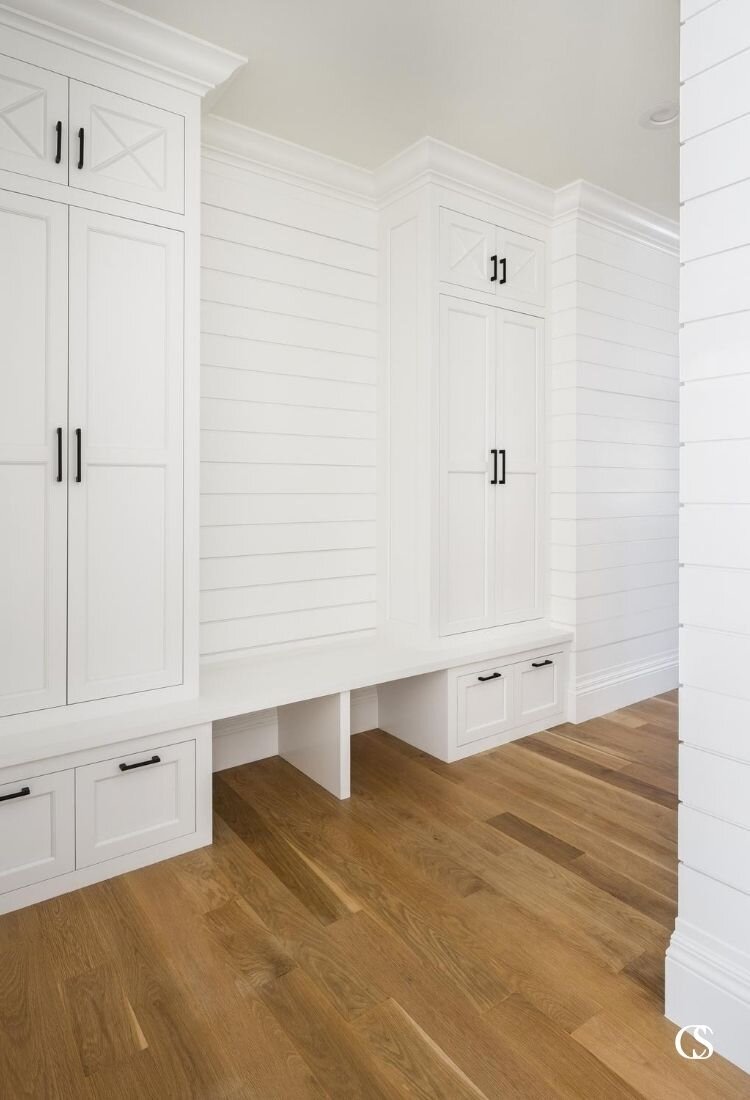
PROJECT DETAILS
Plenty of room to store coats, gear, and shoes—and a convenient built-in bench.
Cabinet Paint: Simply White by Benjamin Moore
Floors: Clear-coated plain sawn white oak
Designer: Christopher Scott Cabinetry & Design
Hardware: Flat black
What Is The Best Flooring For A Mudroom?
Again, the purpose of a mudroom is to keep the yuck out of your house—whether that yuck is wetness, dirt, or clutter—which means that the best mudroom flooring should act as a quality buffer between that grossness and the clean, comfortable haven of your home. So our best suggestions for mudroom flooring are going to be hardworking and durable materials like tile, stone, or brick. These are hard to beat in a great mudroom design, whereas wood is less desirable simply due to the nature of the room bearing the brunt of family foot traffic and stuff.
3 Things To Consider For Mudroom Flooring
Clearly, it’s important to choose the right flooring for your mudroom. So how exactly do you make that decision? Here are three important things to consider when deciding on your mudroom floors.
Durability
As discussed above, durability is an absolute necessity when it comes to mudroom flooring. You need something that can withstand the brunt of dirt and traffic as well as the other ins and outs of being a key point of entry. Think about bringing new furniture into your home or needing to remove an old dishwasher. These jobs can be difficult, messy, and even damaging if your mudroom floors aren’t up to the task. This type of mudroom wear and tear is yet another reason we could extol the virtues of stone, tile, and brick over and over. And while wood is less durable against gouges and stains, if well sealed and properly cared for, it can also be a beautiful option for mudroom flooring.
Cleanability
Because the mudroom is bound to be the place people track in mud, rain, and other gunk from outside, you’ll want flooring that’s easy to care for and clean. Sweeping, mopping, vacuuming, and treating your mudroom floors will doubtless be part of its cleanup routine so you want to choose something that appeals to you. Textured materials may not be your friend here, whereas dark-colored grout or deeper stained wood flooring can be good ways to mask some of the guaranteed mess between cleanings as well.
Style
The modern mudroom should be a place of style and beauty in addition to its workhorse qualities. And while they may not be commonly seen by company, there is inherent value added to your home and your life when the first thing you see as you walk inside is something that makes you smile. Choose flooring for your mudroom that suits the aesthetics of your home as well as your own personal style. Whether that means embracing a bold pattern or keeping it simple, the look of your mudroom flooring should never be swept under the rug.
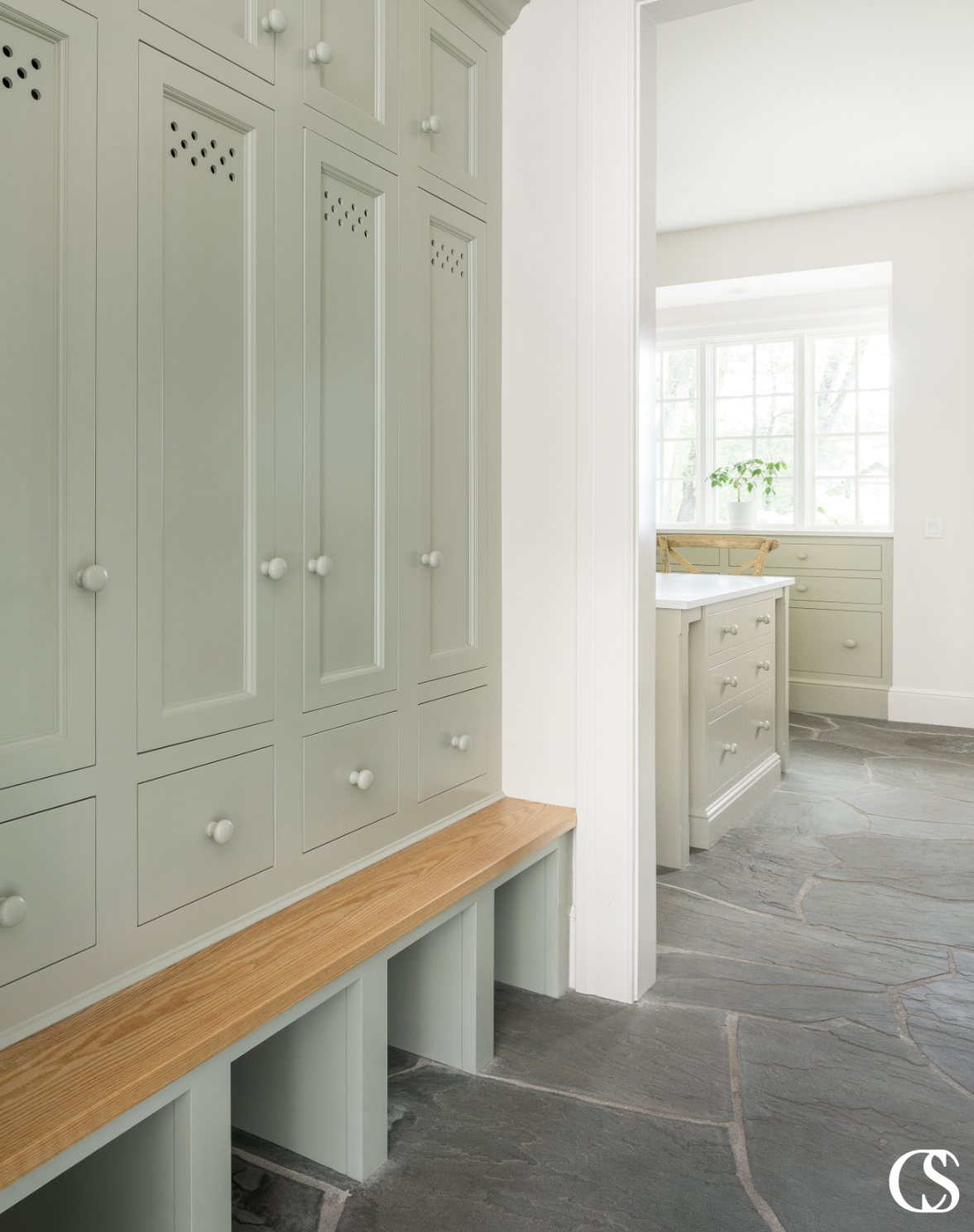
PROJECT DETAILS
This flagstone floor stands up well to wet and muddy boots. The vented locker doors are also designed to allow for air circulation and for coats to dry out.
Cabinet Paint: French Gray by Farrow & Ball
Seat Finish: Clear coated white oak
Floors: Flagstone
Designer: Christopher Scott Cabinetry & Design
Hardware: Painted maple
How Do You Decorate A Mudroom?
A mudroom is a great place for organization. Decorating a mudroom should include reminder-type decor such as chalkboards, whiteboards, cork boards or magnet boards to help with scheduling and organizing incoming and outgoing mail and notes. Your mudroom will need flooring that is durable and water-resistant, but that doesn’t mean it can’t make a beautiful statement as well. A mudroom bench should be both cute and functional, preferably with dedicated storage space within or beneath it.
Mudroom cabinets should be spacious and strategically laid out with storage options that fit your family’s interests and climate, complete with timeless hardware that reflects your personal aesthetic. For example…
-
Love skiing? You’ll want room to hang ski bags and flooring that can handle melting snow.
-
Rainy region? You’ll need a spot for umbrellas, rain boots, and vented storage to allow things to dry.
-
Young kids? You’ll want to hang your hooks a bit lower so little ones can hang up their own bags and coats.
-
Dog lover? You can incorporate a kennel into your design.
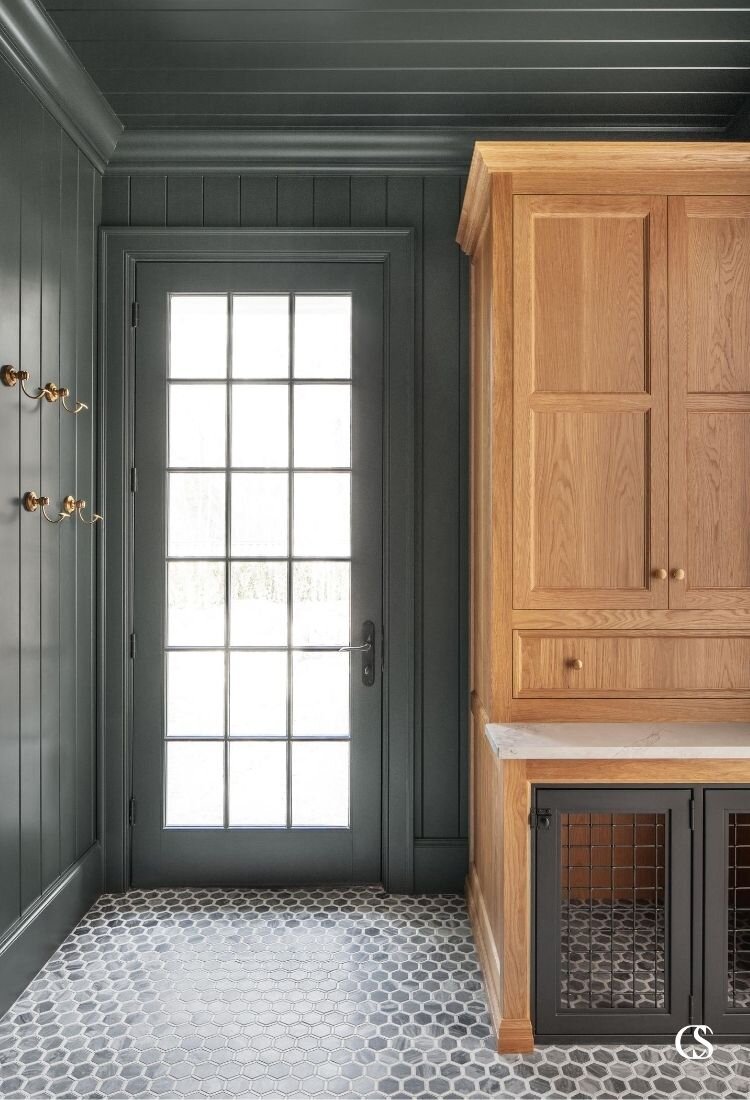
PROJECT DETAILS
See that little spot under the cabinet? That’s a cozy dog kennel, built right into the mudroom cabinetry design.
Paint: Down Pipe by Farrow & Ball
Wood: Clear coated, plain sawn white oak.
Dog Door: Powder-coated steel
Floors: Hexagon gray marble
Designer: Christopher Scott Cabinetry & Design
Hardware: Unlacquered brass
The list could go on. The point is to think about your pain points and to design to create good habits and flow through your home.
Best Mudroom Ideas: Our Favorites And Why
Each mudroom will be as unique as the family whose home it is in, but we do have a few favorite mudroom ideas that are sure to make your space even more practical without sacrificing the pretty.
-
Cabinet benches with open cubbies underneath to allow for quick shoe removal and storage.
-
Drawers underneath mudroom benches if you’d rather keep everything out of sight.
-
Consider wider locker doors for less cramming and abuse of the cabinets.
-
Lots of benchtop space for sitting down to remove shoes or setting down bags while removing coats.
-
Maybe even a separate stool in a corner that is small enough to not invite clutter but allows for short term seating.
-
Make a statement with unique mudroom flooring design or cabinet doors or hardware—remember, the utilitarian nature of the mudroom doesn’t have to make it uninviting.
Just remember that the mudroom is one of the most worn-out rooms in a house so being methodical and efficient in this space can lead to much more satisfaction in the use of the space and in the overall cleanliness of the rest of your home.
How Big Should A Mudroom Be?
A mudroom should be as big as your family requires, but if I had to put a number to it, I’d say 20 square feet per person living in the house—minimum. That will ensure that the mudroom size is sufficient to accommodate the inevitable stuff of each person in the household and still allow for ease of high traffic in the space.
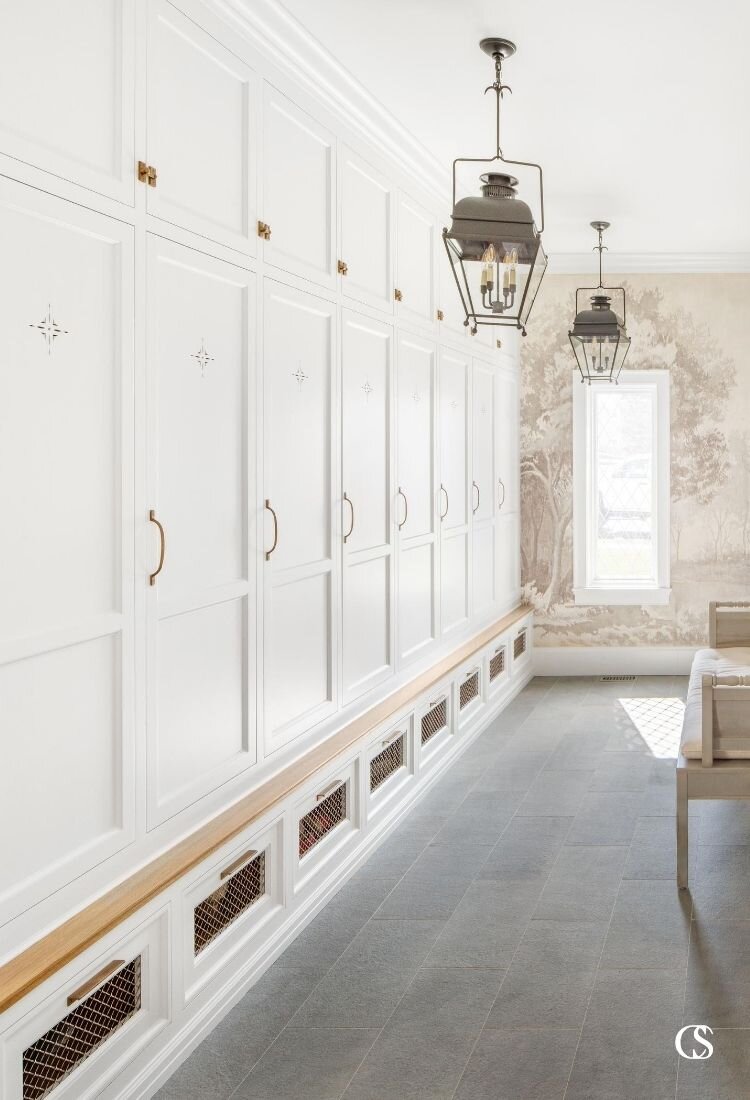
PROJECT DETAILS
This mudroom has room for a crowd and features vented grid drawers along the bottom.
Cabinet Paint: Custom-matched to a tone in the wallpaper
Floors: Slate
Designer: Christopher Scott Cabinetry & Design
Hardware: Antiqued brass
What Is A Good-Sized Mudroom?
A good mudroom size should follow the approximate 20-foot-per-person rule. For example, for a family of 5, a mudroom should be around 15’ x 7’ or even 12’ x 10’. This will all depend on the layout of your home and the plans for cabinetry and storage benches in the mudroom.
You can see more of my design projects—kitchens, bathrooms, built-ins, hardware, and furniture—on Instagram, Facebook, Tradition Hardware, or Pinterest.
Make a statement with unique mudroom flooring design or cabinet doors or add a bit of interest with some eye-catching hardware—remember, the utilitarian nature of the mudroom doesn’t have to make it uninviting.
Just remember that the mudroom is one of the most worn-out rooms in a house so being methodical and efficient in this space can lead to much more satisfaction in the use of the space and in the overall cleanliness of the rest of your home.
Looking for help with your custom cabinetry and layout design? No matter where you are in the nation, from our home base in Utah from coast to coast, you can contact me here if you are looking for help with your custom cabinetry and layout design. You can contact me here.

